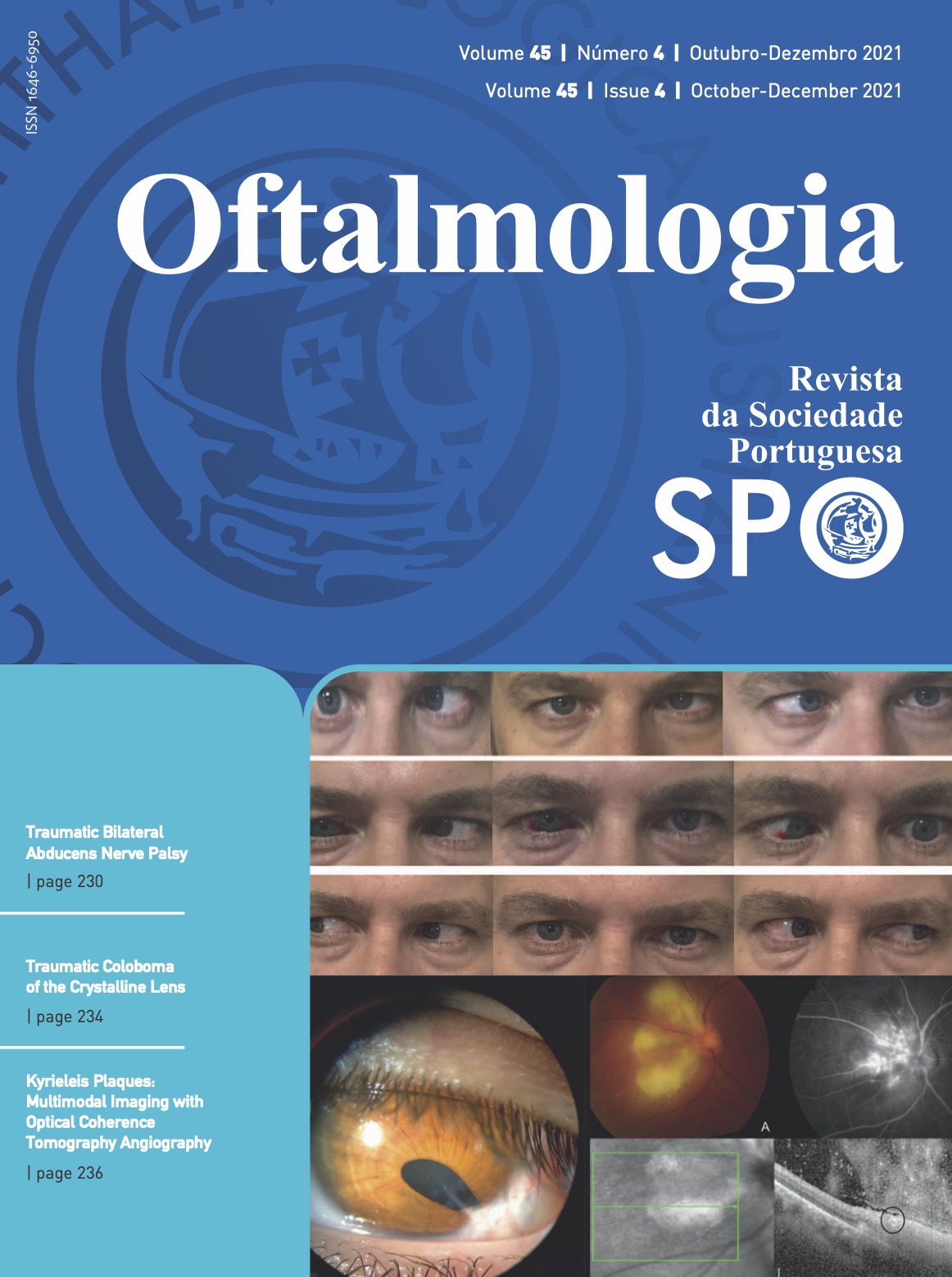Antitubercular Therapy Use in Patients With Ocular Inflammatory Diseases in an Ophthalmology Tertiary Center in Portugal
DOI:
https://doi.org/10.48560/rspo.25651Keywords:
Antitubercular Agents, Interferon-gamma Release Assay, Latent Tuberculosis, Tuberculin Test, Tuberculosis, OcularAbstract
Introduction: Ocular tuberculosis (OTB) is a rare extrapulmonary form of tuberculosis (TB). Diagnosis is usually presumptive, based on local epidemiologic factors, ocular phenotype, and corroborating immunologic tests: tuberculin skin test (TST), interferon-gamma release assay (IGRA) or both. The aim of this study was to characterize patients who were treated with antitubercular therapy (ATT) for OTB or latent tuberculous infection (LTBI) at an uveitis clinic in a tertiary referral hospital.
Methods: Patients seen in our uveitis clinic between 2015 and 2021 that had ATT were included and divided into OTB group and LTBI group. Clinical data was analyzed with SPSS statistics®.
Results: We included 38 patients with OTB with a mean age of 53.39 years old. A percentage of 21.1% were immigrants and 2.6% were HIV+. A positive IGRA and/or a TST≥15 mm was found on 97.38%. The most prevalent form of OTB was panuveitis (36.8%), followed by posterior uveitis (21.1%), anterior uveitis (13.2%), intermediate uveitis (13.2%), retinal vasculitis (7.9%), scleritis (5.3%) and episcleritis (2.6%). ATT on 81.6% of patients was a combination of rifampin (RIF), isoniazid (INH), ethambutol and pyrazinamide for the first 2 months followed by INH+RIF. The mean duration of treatment was 8.7 months. The group of LTBI had 16 patients, 18.8% were immigrants and none was HIV+. The diagnosis of 93.75% of patients was based on a positive IGRA and/or TST≥15 mm. The majority (93.75%) were tested and treated prophylactically before starting immunosuppression.
Conclusion: TB incidence in Portugal it is still one of the highest in the European Union. Immigrants represented 24.6% of cases in 2019, which is similar to the prevalence found in our study. Conversely, 9% of TB patients in 2019 were HIV+, which is higher than what was found. Almost every patient with ocular inflammation followed in our uveitis clinic is tested for TB and the threshold to start ATT is low, but positive test results should be considered for the initiation of ATT only in the context of a strong clinical suspicion.
Downloads
References
– Asia Pacific - American Academy of Ophthalmology. Ocular Tuberculosis (TB) [Internet] [cited September 2021]. Available from: https://www.aao.org/topic-detail/ocular-tuberculosis-tb--asia-pacific-2
- Testi I, Agrawal R, Mehta S, Basu S, Nguyen Q, Pavesio C, Gupta V. Ocular tuberculosis: Where are we today? Indian J Ophthalmol. 2020;68:1808-17. doi: 10.4103/ijo.IJO_1451_20.
- Figueira L, Fonseca S, Ladeira I, Duarte R. Ocular tuberculosis: Position paper on diagnosis and treatment management. Rev Port Pneumol. 2017;23:31-8. doi: 10.1016/j.rppnen.2016.10.004.
- Agrawal R, Agarwal A, Jabs DA, Kee A, Testi I, Mahajan S, et al. Standardization of Nomenclature for Ocular Tuberculosis - Results of Collaborative Ocular Tuberculosis Study (COTS) Workshop. Ocul Immunol Inflamm. 2019;1-11. doi: 10.1080/09273948.2019.1653933
- Agrawal R, Testi I, Bodaghi B, Barisani-Asenbauer T, McCluskey P, Agarwal A, et al. Collaborative Ocular Tuberculosis Study Consensus Guidelines on the Management of Tubercular Uveitis-Report 2: Guidelines for Initiating Antitubercular Therapy in Anterior Uveitis, Intermediate Uveitis, Panuveitis, and Retinal Vasculitis. Ophthalmology. 2021;128:277-87. doi: 10.1016/j.ophtha.2020.06.052.
- Yeh S, Sen HN, Colyer M, Zapor M, Wroblewski K. Update on ocular tuberculosis. Curr Opin Ophthalmol. 2012;23:551-6. doi: 10.1097/ICU.0b013e328358ba01.
- Agrawal R, Testi I, Mahajan S, Yuen YS, Agarwal A, Kon OM, et al. Collaborative Ocular Tuberculosis Study Consensus Guidelines on the Management of Tubercular Uveitis-Report 1: Guidelines for Initiating Antitubercular Therapy in Tubercular Choroiditis. Ophthalmology. 2021;128:266-76. doi: 10.1016/j.ophtha.2020.01.008.
- Lee C, Agrawal R, Pavesio C. Ocular Tuberculosis--A Clinical Conundrum. Ocul Immunol Inflamm. 2016;24:237-42. doi: 10.3109/09273948.2014.985387.
- Trad S, Saadoun D, Errera MH, Abad S, Bielefeld P, Terrada C, et al. Tuberculose oculaire. Rev Med Interne. 2018;39:755-64. doi: 10.1016/j.revmed.2018.05.003.
- Hasan T, Au E, Chen S, Tong A, Wong G. Screening and prevention for latent tuberculosis in immunosuppressed patients at risk for tuberculosis: a systematic review of clinical practice guidelines. BMJ Open. 2018;12;:e022445. doi: 10.1136/bmjopen-2018-022445.
- Programa Nacional para a Tuberculose. Relatório de Vigilância e Monotorização da Tuberculose em Portugal. Dados definitivos 2018/19. Lisboa: Direção-Geral da Saúde; 2020.
- Testi I, Agrawal R, Mahajan S, Agarwal A, Gunasekeran DV, Raje D, et al. Gupta V. Tubercular Uveitis: Nuggets from Collaborative Ocular Tuberculosis Study (COTS)-1. Ocul Immunol Inflamm. 2019;25:1-9. doi: 10.1080/09273948.2019.1646774.
Gupta A, Sharma A, Bansal R, Sharma K. Classification of intraocular tuberculosis. Ocul Immunol Inflamm. 2015;23:7-13. doi: 10.3109/09273948.2014.967358.
Downloads
Published
How to Cite
Issue
Section
License
Copyright (c) 2021 Revista Sociedade Portuguesa de Oftalmologia

This work is licensed under a Creative Commons Attribution-NonCommercial 4.0 International License.
Do not forget to download the Authorship responsibility statement/Authorization for Publication and Conflict of Interest.
The article can only be submitted with these two documents.
To obtain the Authorship responsibility statement/Authorization for Publication file, click here.
To obtain the Conflict of Interest file (ICMJE template), click here





